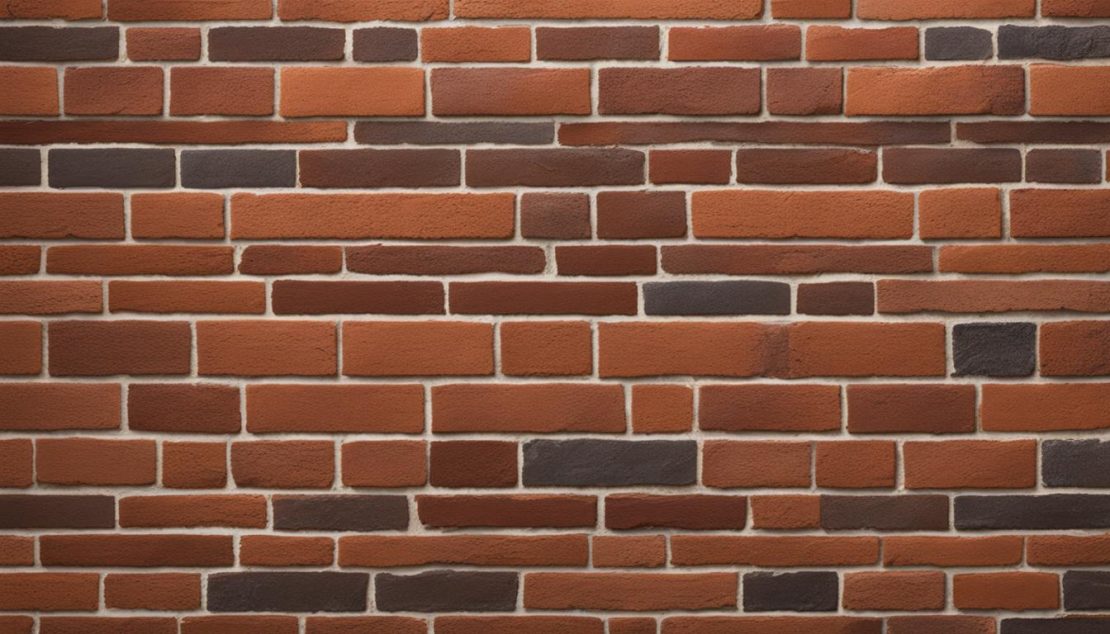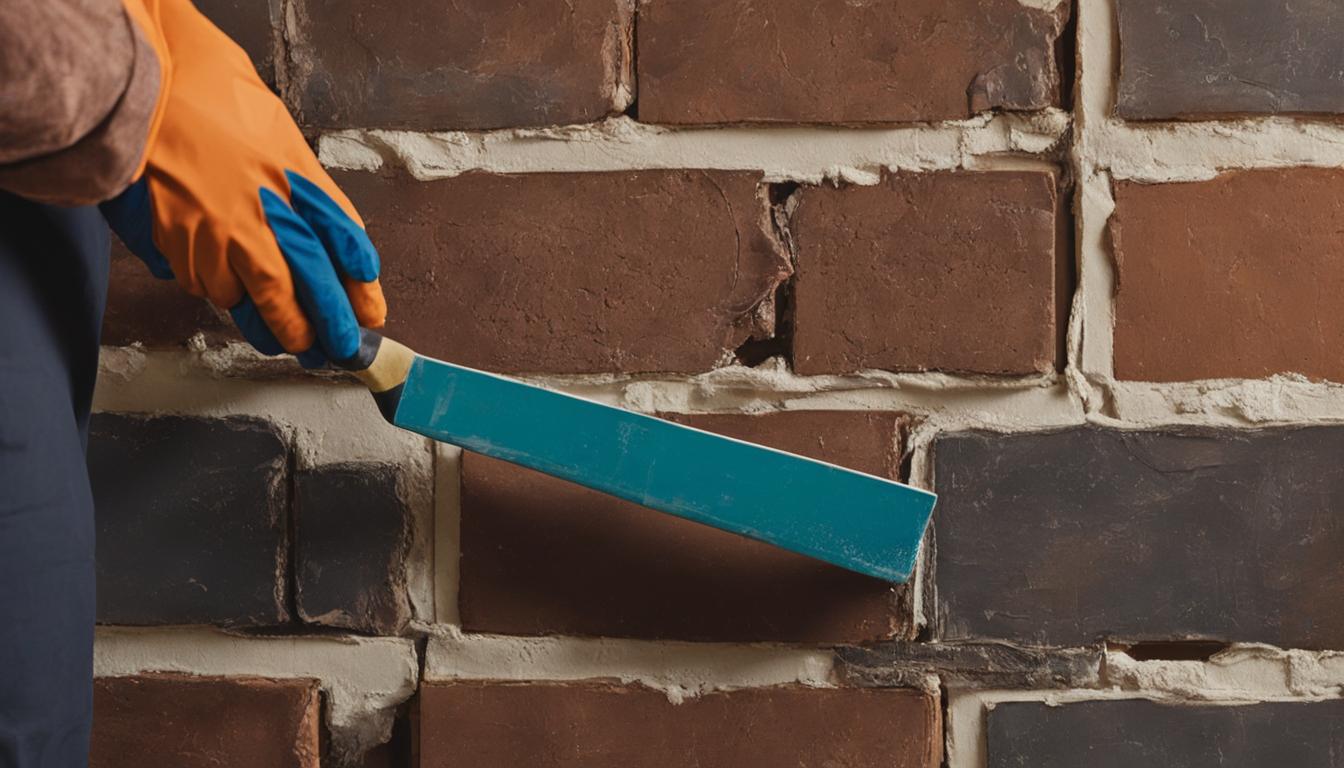If you have an interior brick wall, chances are you love the charm and character it brings to your space. However, over time, the brick can become worn and damaged. That’s why it’s essential to seal your interior brick wall to enhance its durability and ensure it remains in excellent condition for years to come.
In this section, we will guide you through the simple steps to effectively seal your interior brick wall. We’ll also share tips and inspiration for incorporating brick walls into your interior decor and explore the various sealant options available. Let’s get started!

An image of a person in work clothes applying sealant to a section of an exposed interior brick wall. They use a paintbrush to carefully spread the sealant in between the individual bricks, ensuring that each crack is filled and protected. In the background, tools such as a trowel or putty knife can be seen lying nearby, along with open containers of sealant. The lighting in the scene is warm and bright, casting long shadows on the rough surface of the brick wall.
Tips for Sealing Interior Brick Wall
Sealing your interior brick wall is not just about enhancing its durability, but it’s also an opportunity to add a unique touch of design to your space. Here are some tips for creating an impressive brick wall design.
1. Incorporate Brick Walls into Your Interior Decor
Brick walls can add a rustic, industrial, or modern touch to your home decor. Depending on your desired look, you can choose to paint your brick wall or leave it exposed to give it a raw, natural feel. For a bold statement, consider using a bold-colored paint and keep the rest of the decor minimal.
2. Create a Focal Point with Your Brick Wall
If you have a large room, consider creating a focal point by using your brick wall as a backdrop. You can preserve the wall’s natural texture and design by applying clear sealant, or you can add a layer of glaze to achieve a smoother finish, allowing your brick wall to become the centerpiece of your space.
3. Mix and Match Textures and Colors
If you have a modern or contemporary interior, you can balance the sleekness of your decor with the rough texture of exposed brick walls. You can also mix and match colors of your brick wall with your interior pieces to create a cohesive look.
4. Use Lighting to Highlight Your Brick Wall
Lighting can significantly enhance the beauty of your brick wall. Install ambient or wall sconces to create a cozy, warm ambiance in your space, while highlighting your brick wall’s unique texture and color.
Sealing your brick wall is an excellent way to protect and extend its lifespan. However, it’s also an opportunity to add a touch of charm and unique design to your space. By following these tips, you can create a beautiful and long-lasting interior brick wall decor that you’ll love for years to come.
Choosing the Right Sealant for Your Brick Wall
When it comes to sealing your interior brick wall, choosing the right sealant is crucial. The sealant you choose will impact the texture, construction style, and desired finish of your brick wall. Here are some factors to consider when selecting the right sealant for your brick wall:
Texture
The texture of your brick wall is an important factor to think about when selecting a sealant. If you prefer a natural, rough texture, use a sealant with a matte or natural finish. Alternatively, if you want a glossy appearance, choose a sealant with a high gloss finish.
Construction Style
The construction style of your brick wall is another important factor to consider. Different styles require different types of sealant. For example, if your brick wall has mortar joints, you will need a sealant that can fill the gaps between the joints, whereas a smooth, mortarless brick wall will require a sealant that can adhere directly to the brick.
Desired Finish
The desired finish of your brick wall is also an important factor when selecting a sealant. If you want a colored brick wall, then choose a sealant that can be mixed with paint to create the desired color. Alternatively, if you prefer a natural brick color, choose a clear coat sealant.
There are various types of sealant available, including water-based sealants, oil-based sealants, and epoxy sealants. Each has its own set of benefits and drawbacks. For example, water-based sealants are easy to apply and have a low VOC content, making them a more eco-friendly option. Epoxy sealants, on the other hand, are extremely durable and provide better protection against water and stains.
Ultimately, the right sealant for your brick wall will depend on a range of factors such as your personal preference for texture and finish, the construction style of your wall, and the level of protection you require. Make sure to read product labels and specifications carefully before selecting a sealant.

Create an image showing different types of sealants being applied to a brick wall. Show the various finishes, such as matte, glossy, and satin, using different textures and shading techniques. Use warm earth tones to capture the natural look of bricks, but provide a clear contrast between each sealant type. Add depth and dimension to the image by showing how each sealant interacts with the porous surface of the brick wall. Show a variety of application methods, including brushes, rollers, and sprayers, to give the viewer a sense of how each finish is achieved.
Step-by-Step Guide to Sealing Your Interior Brick Wall
Now that you have chosen the right sealant for your specific interior brick wall, it’s time to start the sealing process. Follow these simple steps:
- Prepare the wall: Clean the interior brick wall thoroughly to remove any dirt or debris. Allow the wall to dry completely before moving onto the next step.
- Protect surrounding surfaces: Cover the surrounding surfaces with drop cloths to protect them from the sealant.
- Apply the sealant: Using a roller or brush, apply the sealant evenly on the interior brick wall. Start from the top and work your way down. Make sure to cover all surfaces of the wall thoroughly.
- Allow time to dry: Let the sealant dry completely before applying a second coat. The drying time will depend on the type of sealant used, so refer to the label instructions for specific drying times.
- Apply a second coat: Once the first coat is dry, apply a second coat of sealant. This will ensure maximum protection and durability for your interior brick wall.
- Finish: Once the second coat is dry, remove the drop cloths, and allow the sealant to cure for the recommended time. Then, enjoy your newly sealed and beautiful interior brick wall for years to come!
Sealing your interior brick wall is an easy process that can enhance its charm and durability. By following these simple steps, you’ll be able to effectively seal your interior brick wall and achieve the desired finish. Remember to choose the right sealant for your specific needs and follow the label instructions for the best results.




